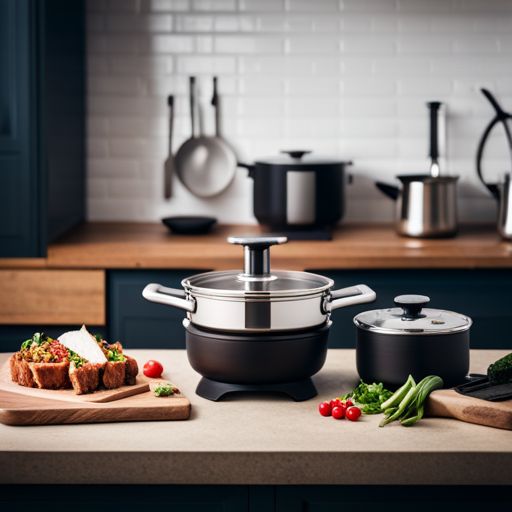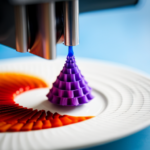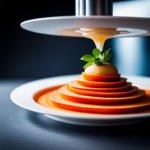Delving into the dichotomy of traditional culinary craftsmanship and cutting-edge 3D printing technology, this article scrutinizes the contrasts and convergences between age-old cooking methods and modern food fabrication techniques.
Through a scientific lens, we explore the historical, cultural, and ethical dimensions, while analyzing the efficacy and creativity of both approaches.
As we embark on this culinary exploration, we aim to ignite a profound appreciation for the artistry and innovation that shape our gastronomic experiences.
Historical Roots of Cooking Techniques
Tracing the historical roots of cooking techniques reveals the evolution of culinary practices across cultures and time periods. Cultural influences have played a significant role in shaping cooking methods, with each region developing its unique culinary traditions. From the use of open flames and rudimentary tools in ancient times to the sophisticated cooking appliances of today, technological advancements have continually transformed the way food is prepared.
The cooking techniques of early civilizations were heavily influenced by the ingredients available in their surroundings, leading to diverse methods such as fermenting, smoking, and drying. As societies progressed, trade and exploration introduced new ingredients and cooking styles, further enriching the global culinary landscape. The invention of the pottery and metal cookware revolutionized cooking methods, allowing for more efficient heat distribution and the creation of complex dishes.
Technological advancements, such as the development of ovens, stoves, and refrigeration, have continued to shape cooking techniques, making it easier to control temperature and experiment with different cooking methods. Moreover, cultural exchanges and migration have led to the fusion of cooking techniques, resulting in the creation of new and innovative culinary approaches.
Understanding the historical roots of cooking techniques provides valuable insight into the rich tapestry of global gastronomy and highlights the interconnectedness of culinary traditions across the world.
Ingredient Selection and Preparation
The evolution of culinary practices across cultures and time periods has necessitated a deliberate selection and meticulous preparation of ingredients, integral to the development of diverse cooking techniques. Ingredient sourcing plays a crucial role in traditional cooking, where locally available produce is often preferred for its freshness and flavor.
In contrast, 3D food printing allows for precise control over ingredient selection, enabling the use of novel components and customized blends. Additionally, traditional cooking methods rely on preparation techniques such as chopping, grinding, and marinating to enhance flavors and textures.
On the other hand, 3D food printing involves ingredient processing at a molecular level, allowing for the creation of unique textures and structures. Furthermore, traditional cooking emphasizes the preservation of nutritional value through careful preparation, such as steaming or stir-frying to retain nutrients.
In comparison, 3D food printing techniques can be optimized to incorporate specific nutrients into the printed food, catering to individual dietary requirements. Understanding the differences in ingredient selection and preparation techniques is crucial for evaluating the potential of 3D food printing as a complement or alternative to traditional cooking methods.
Culinary Creativity and Customization
Culinary creativity and customization play a pivotal role in both traditional cooking and food 3D printing techniques.
Flavor customization options in traditional cooking involve the manipulation of ingredients, cooking methods, and seasoning to achieve a desired taste profile.
On the other hand, food 3D printing allows for culinary artistic expression through the precise layering and shaping of ingredients to create visually stunning and innovative dishes.
Flavor Customization Options
One can achieve a high degree of flavor customization through 3D food printing, allowing for unprecedented culinary creativity and personalization. Customized flavors can be tailored to individual taste preferences, offering a wide array of options for flavor innovation.
This technology enables the precise layering of ingredients and the creation of intricate designs that can enhance the overall taste experience. Personalized seasoning blends can be developed with exact measurements to ensure consistency and accuracy in flavor profiles.
Additionally, 3D food printing allows for the incorporation of unique and unconventional ingredients, expanding the possibilities for creating distinctive flavors. The ability to control the composition and distribution of ingredients provides chefs and food manufacturers with the opportunity to experiment with new flavor combinations, ultimately leading to the development of novel culinary experiences.
Culinary Artistic Expression
An essential aspect of culinary artistic expression lies in the ability to innovate and customize food creations to elevate the dining experience.
Artistic presentation plays a pivotal role in this process, with chefs exploring innovative ways to present dishes that engage all the senses.
Culinary innovation, driven by advancements in technology and techniques, allows for unprecedented levels of customization, enabling chefs to create unique and visually stunning culinary masterpieces.
This level of creativity extends beyond traditional cooking methods and is exemplified in the emerging realm of 3D food printing, where intricate designs and structures can be crafted with precision.
Such advancements in culinary expression not only offer new avenues for creativity but also enhance the overall dining experience for consumers.
This emphasis on culinary creativity and customization directly impacts the efficiency and time considerations in food production.
Time and Efficiency in Food Production
The comparison of traditional cooking and food 3D printing techniques in terms of time and efficiency in food production is a crucial aspect of evaluating their practicality and effectiveness.
This discussion will explore the differences in cooking time versus printing time, the labor and automation involved in each method, and the utilization of resources in traditional cooking and 3D food printing.
Cooking Time Vs Printing
When comparing the production time between traditional cooking and food 3D printing techniques, it is essential to assess the efficiency of both methods in delivering high-quality food products.
The cooking time in traditional methods varies based on the complexity of the dish and can range from minutes to several hours. On the other hand, food 3D printing offers rapid printing speed, with intricate designs and complex structures being created in a fraction of the time it would take to cook them conventionally.
Factors influencing cooking time include preparation, cooking, and plating, while in 3D printing, the time is primarily determined by the design complexity, layer thickness, and printing speed.
- Traditional cooking methods’ cooking time can be influenced by factors such as heat source, preparation time, and cooking technique.
- Food 3D printing’s printing speed is primarily determined by design complexity, layer thickness, and printing speed.
- Efficiency in delivering high-quality food products is influenced by the cooking time and printing speed.
- Traditional cooking involves manual supervision, whereas 3D printing is automated, potentially saving time and labor.
- The rapid printing speed of food 3D printing allows for quick production of complex food designs, reducing overall production time and increasing efficiency.
Labor and Automation
As automation becomes increasingly prevalent in food production, the efficiency and time-saving benefits of labor and automation in food 3D printing are evident. Technological automation allows for precise control over the food printing process, minimizing the need for manual labor and reducing the potential for human error. This results in enhanced labor efficiency as the 3D printing process can operate continuously with minimal human intervention once set up.
Traditional cooking methods often require constant monitoring and manual intervention, leading to higher labor input and potential inconsistencies in the final product. In contrast, food 3D printing can significantly reduce the time required for food preparation, enabling the production of complex dishes in a fraction of the time it would take using traditional cooking methods.
The integration of labor-saving automation in food 3D printing showcases the potential for revolutionizing the efficiency of food production.
Resource Utilization Comparison
With regard to resource utilization comparison in food production, it is essential to assess the time and efficiency differences between traditional cooking and food 3D printing techniques.
-
Resource Efficiency: Traditional cooking often requires more resources, such as water and fuel, compared to food 3D printing, which can be more precise in its resource usage.
-
Waste Reduction: Food 3D printing can significantly reduce food waste by using only the necessary ingredients, whereas traditional cooking may lead to more leftover or unused food.
-
Energy Consumption: Traditional cooking methods may consume more energy, especially when using appliances such as ovens and stoves, whereas food 3D printing can be more energy-efficient.
-
Material Usage: Food 3D printing can use precise amounts of ingredients, reducing material usage and potential waste, while traditional cooking may involve more significant material usage and potential waste.
Flavor and Texture Considerations
An important consideration in comparing traditional cooking and food 3D printing techniques is the impact on flavor and texture.
Traditional cooking methods often rely on the complex interactions of flavor profiles and sensory experiences. The process of texture analysis and mouthfeel perception is integral to the traditional culinary experience.
With food 3D printing, there is a necessity to ensure that the printed food not only looks appealing but also delivers on flavor and texture. The challenge lies in replicating the intricate sensory experiences and mouthfeel perception that are achieved through traditional cooking.
In traditional cooking, the manipulation of ingredients, application of heat, and the physical manipulation of food create diverse flavor profiles and textures, engaging multiple sensory receptors in the process.
However, in food 3D printing, the ability to replicate these complex interactions is still evolving. The precise control over texture and flavor in 3D printed food is a critical area of research and development.
Future advancements in 3D food printing technology will likely focus on achieving a more sophisticated understanding and replication of the intricate flavor and texture experiences found in traditional cooking.
Cultural and Ethical Implications
How do cultural and ethical factors influence the adoption and acceptance of food 3D printing in different societies and communities?
Cultural adaptation and ethical considerations play a pivotal role in shaping the reception of food 3D printing across diverse cultural and societal contexts. Several factors contribute to this influence, including:
-
Cultural Perceptions: Different societies hold varying attitudes towards food preparation and consumption, impacting the acceptance of 3D printed food.
-
Traditional Culinary Practices: The preservation of traditional cooking methods and recipes may pose challenges to the integration of 3D printed food in some communities.
-
Ethical Implications: Concerns regarding the use of 3D printing technology in food production, such as sustainability and environmental impact, can sway ethical considerations.
-
Cultural Significance of Food: The cultural and symbolic meanings attached to food may affect the willingness to embrace 3D printed alternatives.
-
Accessibility and Affordability: Socioeconomic factors influence the accessibility and affordability of 3D printed food, affecting its adoption in different communities.
Understanding the complex interplay of cultural and ethical factors is crucial for the successful integration of food 3D printing in diverse societies and communities. The next section will delve into the advancements in culinary technology.
Advancements in Culinary Technology
The evolution of culinary technology has revolutionized food preparation and presentation. Advancements in technology have led to the development of 3D food printing, which is changing the landscape of culinary craftsmanship. Traditional techniques, while still valued and utilized, are being complemented by these technological advancements.
3D food printing is a cutting-edge technology that allows chefs to create intricate and customized designs with food ingredients. This technology enables the precise layering of edible materials to construct various shapes, textures, and flavors that would be challenging to achieve using traditional methods. It offers a new level of creativity and precision in culinary arts, opening up possibilities for innovative dishes and presentations.
Despite these advancements, traditional culinary techniques remain essential. The expertise and artistry of chefs are not replaced but enhanced by 3D food printing. The combination of traditional craftsmanship with technological advancements results in a new era of culinary creativity and presentation.
As technology continues to advance, it is exciting to contemplate the future possibilities and the continued evolution of culinary arts.
Frequently Asked Questions
What Are the Environmental Impacts of Traditional Cooking Techniques Compared to 3D Printing Food Technology?
In assessing the environmental impacts of traditional cooking versus 3D printing food technology, factors such as waste reduction, energy consumption, and resource utilization are critical. Understanding these elements is essential to evaluating the sustainability of each method.
How Do Traditional Cooking and 3D Printing Techniques Differ in Terms of Nutritional Value and Health Impact of the Food Produced?
When comparing traditional cooking and 3D printing techniques, it is vital to assess their nutritional value and health impact. Understanding the cost difference and future implications of these methods is crucial for informed decision-making in food production.
Are There Any Limitations or Drawbacks to Using 3D Printing Technology for Food Production Compared to Traditional Cooking Methods?
When considering the use of 3D printing technology for food production, it is important to address its limitations and drawbacks. These may include challenges related to efficiency, customization, and maintaining the sensory experience associated with traditional cooking methods.
How Does the Cost of Food Production Differ Between Traditional Cooking and 3D Printing Techniques?
The cost difference between traditional cooking and 3D printing techniques significantly impacts production efficiency. Understanding this economic dynamic is akin to calibrating the precise balance of ingredients for a culinary masterpiece.
What Are the Potential Future Implications of Widespread Adoption of 3D Printing Technology for Food Production on Traditional Culinary Practices and Cultural Food Traditions?
The widespread adoption of 3D printing technology for food production has potential future implications on traditional culinary practices and cultural food traditions, impacting cultural preservation and culinary innovation. It necessitates careful consideration of preserving cultural authenticity amidst culinary advancements.
Conclusion
In conclusion, the comparison between traditional cooking and 3D food printing techniques reveals the historical roots, ingredient selection and preparation, culinary creativity, time and efficiency, flavor and texture considerations, as well as cultural and ethical implications.
Advancements in culinary technology have significantly impacted the way food is produced and consumed. It is clear that both traditional cooking and 3D food printing have their own unique strengths and limitations, offering opportunities for further exploration and innovation in the culinary world.


